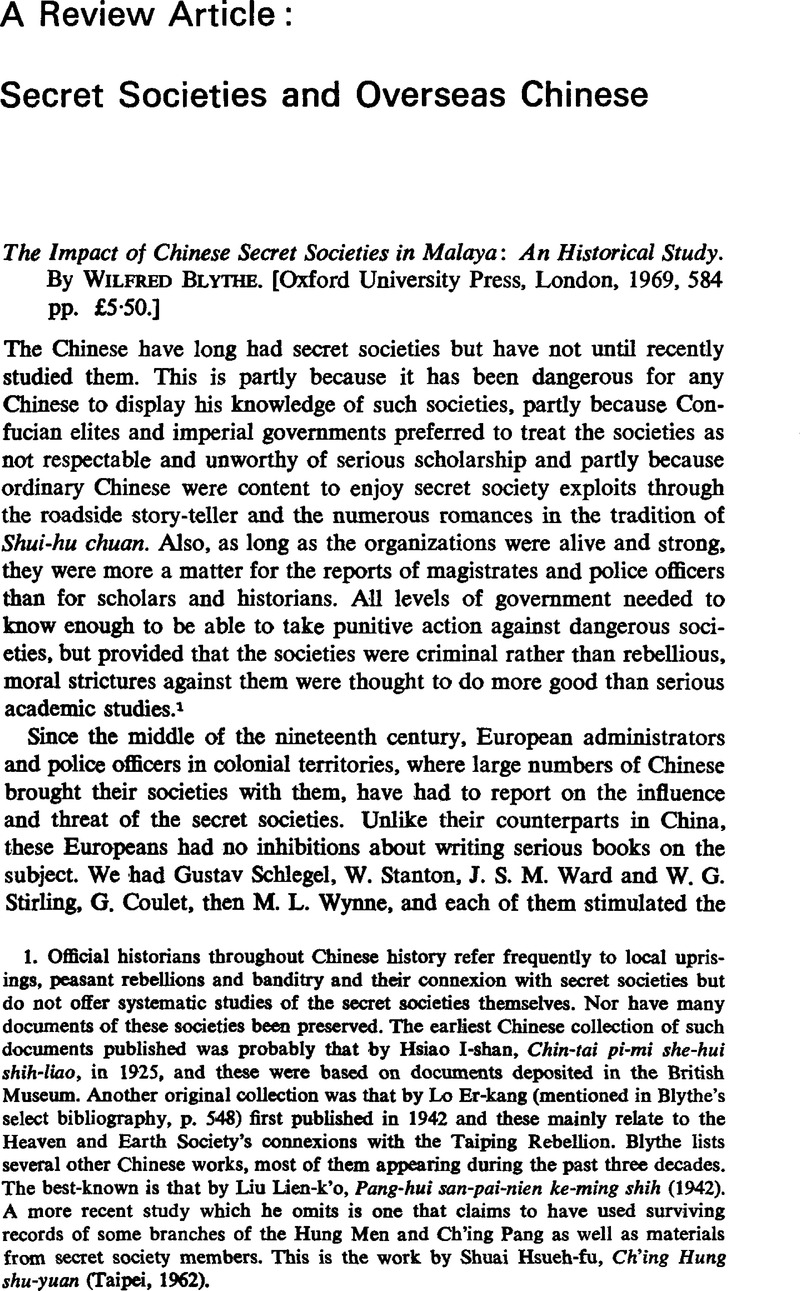No CrossRef data available.
Article contents
Secret Societies and Overseas Chinese
Published online by Cambridge University Press: 17 February 2009
Abstract

- Type
- Review Article
- Information
- Copyright
- Copyright © The China Quarterly 1971
References
1. Official historians throughout Chinese history refer frequently to local uprisings, peasant rebellions and banditry and their connexion with secret societies but do not offer systematic studies of the secret societies themselves. Nor have many documents of these societies been preserved. The earliest Chinese collection of such documents published was probably that by I-shan, Hsiao, Chin-tai pi-mi she-hui shih-liao, in 1925Google Scholar, and these were based on documents deposited in the British Museum. Another original collection was that by Lo Er-kang (mentioned in Blythe's select bibliography, p. 548) first published in 1942 and these mainly relate to the Heaven and Earth Society's connexions with the Taiping Rebellion. Blythe lists several other Chinese works, most of them appearing during the past three decades. The best-known is that by Lien-k'o, Liu, Pang-hui san-pai-nien ke-ming shih (1942).Google Scholar A more recent study which he omits is one that claims to have used surviving records of some branches of the Hung Men and Ch'ing Pang as well as materials from secret society members. This is the work by Hsueh-fu, Shuai, Ch'ing Hung shu-yuan (Taipei, 1962).Google Scholar
2. The works of Schlegel, Stanton, Ward and Stirling, Coulet and Wynne are all listed in Blythe's bibliography. It is worth noting that they were widely used for a number of recent conference sessions on Chinese secret societies, notably the papers which have been edited by Jean Chesneaux (Secret Societies in China in the 19th and 20th Centuries) and recent articles by Stuart Schrarn (The China Quarterly, No. 27 (07-09 1966)Google Scholar) and Jerome Ch'en (Journal of Asian Studies, Vol. XXIX, No. 4 (1970)).Google Scholar
3. For a discussion of Purcell's work, see the memoir by Sprenkel, S. van der in Ch'en, J. and Tarling, N. (eds.), Studies in the Social History of China and South-East Asia: Essays in Memory of Victor Purcell (Cambridge, 1970)Google Scholar; also a short bibliography of his writings on pp. 403–405.
4. Blythe's bibliography lists the works of Comber and Jackson, also two early works by E. Thio and E. Sadka, but omits Turnbull, C. M., “Communal Disturbances in the Straits Settlements in 1887,” JMBRAS, Vol. 31, No. 1, pp. 94–144.Google Scholar A more recent study which touches on the problem of control over the Chinese is Sadka, E., The Protected Malay States, 1874–1895 (Kuala Lumpur, 1968)Google Scholar; also Turnbull, C. M., “Internal Security in the Straits Settlements, 1826–1867,” Journal of Southeast Asian Studies, Vol. I, No. 17, pp. 37–53.Google Scholar Also of importance is the forthcoming book by Kim, Khoo Kay, The Western Malay States, 1861–1873.Google Scholar
5. Two recent articles which open up this field are Seng, Png Poh, “The Kuomintang in Malaya, 1912–1941,” Journal of Southeast Asian History, Vol. 2, pp. 1–32Google Scholar, and Fatt, Yong Ching, “A Preliminary Study of Chinese Leadership in Singapore, 1900–1941,” Journal of Southeast Asian History, Vol. IX, No. 2, pp. 258–285.Google Scholar Another study which examines the first part of this period in great detail is the forthcoming book by Ching-hwang, Yen, The Chinese Revolutionary Movement in Malaya, 1900–1911.Google Scholar
6. Allen, J. de V., The Malayan Union (New Haven, 1967)Google Scholar; Stenson, M. R., Repression and Revolt: the Origin of the 1948 Communist Insurrection in Malaya and Singapore (Athens, Ohio, 1969)Google Scholar and Industrial Conflict in Malaya: Prelude to the Communist Revolt of 1948 (London, 1970).Google Scholar Anthony Short's study on the Emergency in Malaya, completed some four years ago, has yet to appear, but we have had brief glimpses of his approach in his “Communism and the Emergency,” in Gungwu, Wang (ed.), Malaysia, a Survey (London, 1964), pp. 149–160Google Scholar; and his “Communism, Race and Politics in Malaysia,” Asian Survey, Vol. X, No. 12 (12 1970), pp. 1081–1089.Google Scholar


